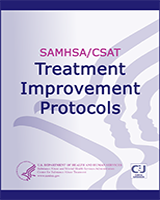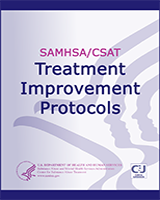NCBI Bookshelf. A service of the National Library of Medicine, National Institutes of Health.
This publication is provided for historical reference only and the information may be out of date.
This TIP, titled LAAM in the Treatment of Opiate Addiction, presents current knowledge about the use of levo-alpha-acetyl-methadol (LAAM), an opioid agonist medication approved for use in 1993. LAAM suppresses opiate withdrawal symptoms for more than 72 hours, and it can be administered no more frequently than every other day. Thus, daily visits to the program clinic are not required for LAAM-maintained patients, as are visits for patients on methadone. In addition to the difference in dosing schedule, no take-home doses of LAAM are permitted under Federal regulations, and women of child-bearing potential must be tested monthly for pregnancy.
Contents
- What Is a TIP?
- Consensus Panel
- Foreword
- Chapter 1 - Introduction
- Chapter 2 - Clinical Profile of LAAM
- Chapter 3 - Clinical Application of LAAM Therapy
- Chapter 4 - Treatment Planning
- Chapter 5 - Management and Administrative Issues
- Chapter 6 - Regulatory and Ethical Issues
- Appendix A - Bibliography
- Appendix B - Training Resources
- Appendix C - Federal Resource Panel
- Appendix D - Field Reviewers
This publication is part of the Substance Abuse Prevention and Treatment Block Grant technical assistance program. This publication was written under contract number ADM 270-91-0007 from the Center for Substance Abuse Treatment of the Substance Abuse and Mental Health Services Administration (SAMHSA). Sandra Clunies, MS, served as the CSAT Government project officer. Robert A Lubran, MS, MPA, was the Government content advisor. Carolyn Davis, Constance Gartner, Linda Harteker, Lise Markl, Barbara Shapiro, and Deborah Shuman served as writers.
The opinions expressed herein are the views of the consensus panel members and do not reflect the official position of CSAT or any other part of the U. S. Department of Health and Human Services (DHHS). No official support or endorsement of CSAT or DHHS for these opinions or for particular instruments or software that may be described in this document is intended or should be inferred. The guidelines proffered in this document should not be considered as substitutes for individualized patient care and treatment decisions.
- Levo-alpha-acetylmethadol (LAAM) versus methadone: treatment retention and opiate use.[Addiction. 2005]Levo-alpha-acetylmethadol (LAAM) versus methadone: treatment retention and opiate use.Longshore D, Annon J, Anglin MD, Rawson RA. Addiction. 2005 Aug; 100(8):1131-9.
- Review Levo-Alpha Acetyl Methadol (LAAM). Its advantages and drawbacks.[J Subst Abuse Treat. 1997]Review Levo-Alpha Acetyl Methadol (LAAM). Its advantages and drawbacks.Finn P, Wilcock K. J Subst Abuse Treat. 1997 Nov-Dec; 14(6):559-64.
- Effects of LAAM and methadone utilization in an opiate agonist treatment program.[Mt Sinai J Med. 2000]Effects of LAAM and methadone utilization in an opiate agonist treatment program.Valdivia JF, Khattak S. Mt Sinai J Med. 2000 Oct-Nov; 67(5-6):398-403.
- l-alpha-Acetylmethadol, l-alpha-acetyl-N-normethadol and l-alpha-acetyl-N,N-dinormethadol: comparisons with morphine and methadone in suppression of the opioid withdrawal syndrome in the dog.[J Pharmacol Exp Ther. 1997]l-alpha-Acetylmethadol, l-alpha-acetyl-N-normethadol and l-alpha-acetyl-N,N-dinormethadol: comparisons with morphine and methadone in suppression of the opioid withdrawal syndrome in the dog.Vaupel DB, Jasinski DR. J Pharmacol Exp Ther. 1997 Nov; 283(2):833-42.
- Review Levo-alpha-acetylmethadol (LAAM): clinical, research, and policy issues of a new pharmacotherapy for opioid addiction.[J Psychoactive Drugs. 1995]Review Levo-alpha-acetylmethadol (LAAM): clinical, research, and policy issues of a new pharmacotherapy for opioid addiction.Prendergast ML, Grella C, Perry SM, Anglin MD. J Psychoactive Drugs. 1995 Jul-Sep; 27(3):239-47.
- LAAM in the Treatment of Opiate AddictionLAAM in the Treatment of Opiate Addiction
Your browsing activity is empty.
Activity recording is turned off.
See more...

